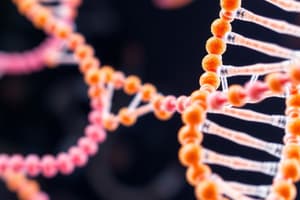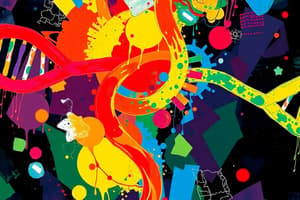Podcast
Questions and Answers
Nucleic acids are essential ______ that serve as the genetic blueprint for all living organisms.
Nucleic acids are essential ______ that serve as the genetic blueprint for all living organisms.
biomolecules
Nucleic acids are long ______ made up of repeating units called nucleotides.
Nucleic acids are long ______ made up of repeating units called nucleotides.
polymers
Each nucleotide consists of three key components: nitrogenous bases, a ______ sugar, and a phosphate group.
Each nucleotide consists of three key components: nitrogenous bases, a ______ sugar, and a phosphate group.
pentose
Deoxyribonucleic acid (DNA) is the primary genetic material in most ______.
Deoxyribonucleic acid (DNA) is the primary genetic material in most ______.
DNA is a double-stranded ______ with complementary base pairing.
DNA is a double-stranded ______ with complementary base pairing.
Ribonucleic acid (RNA) is involved in ______ synthesis and gene regulation.
Ribonucleic acid (RNA) is involved in ______ synthesis and gene regulation.
Messenger RNA (mRNA) carries genetic instructions from DNA to ______ in the cytoplasm.
Messenger RNA (mRNA) carries genetic instructions from DNA to ______ in the cytoplasm.
The central dogma of molecular biology outlines the flow of genetic information in a biological ______.
The central dogma of molecular biology outlines the flow of genetic information in a biological ______.
The flow of genetic information follows a ______ path from DNA to RNA to Protein.
The flow of genetic information follows a ______ path from DNA to RNA to Protein.
The process of ______ ensures that daughter cells inherit identical genetic material.
The process of ______ ensures that daughter cells inherit identical genetic material.
Transcription is the process by which a segment of DNA is copied into ______.
Transcription is the process by which a segment of DNA is copied into ______.
Translation occurs at the ______, where mRNA is translated into proteins.
Translation occurs at the ______, where mRNA is translated into proteins.
DNA has ______ sugar, while RNA has ribose sugar.
DNA has ______ sugar, while RNA has ribose sugar.
RNA contains ______ instead of thymine.
RNA contains ______ instead of thymine.
DNA is ______-stranded, while RNA is single-stranded.
DNA is ______-stranded, while RNA is single-stranded.
DNA primarily functions in storing ______ information.
DNA primarily functions in storing ______ information.
Nucleosides are formed when nitrogenous bases are attached to the pentose sugar (D-ribose or 2-deoxy-D-ribose) via a beta-N-glycosidic bond between the sugar's 1st carbon and the nitrogen atom of the ______.
Nucleosides are formed when nitrogenous bases are attached to the pentose sugar (D-ribose or 2-deoxy-D-ribose) via a beta-N-glycosidic bond between the sugar's 1st carbon and the nitrogen atom of the ______.
Purine nucleosides end in '-sine' and pyrimidine nucleosides in '-______'.
Purine nucleosides end in '-sine' and pyrimidine nucleosides in '-______'.
Phosphates contribute to the acidic nature and negative ______ of nucleic acids.
Phosphates contribute to the acidic nature and negative ______ of nucleic acids.
When a nucleoside is esterified to a phosphate group, it forms a ______ or nucleoside monophosphate.
When a nucleoside is esterified to a phosphate group, it forms a ______ or nucleoside monophosphate.
The addition of a second phosphate group to a nucleoside results in a nucleoside ______.
The addition of a second phosphate group to a nucleoside results in a nucleoside ______.
DNA serves as the repository of genetic information, encoding instructions necessary for ______ development, functioning, and reproduction.
DNA serves as the repository of genetic information, encoding instructions necessary for ______ development, functioning, and reproduction.
Nucleotides such as ATP and GTP are critical for cellular energy ______, fueling various biochemical processes.
Nucleotides such as ATP and GTP are critical for cellular energy ______, fueling various biochemical processes.
Certain RNA molecules, like the ribosome, act as ______.
Certain RNA molecules, like the ribosome, act as ______.
Ribozymes catalyze biochemical reactions, such as the formation of ______ bonds during protein synthesis.
Ribozymes catalyze biochemical reactions, such as the formation of ______ bonds during protein synthesis.
Deoxyribonucleic acid (DNA) is composed of four deoxyribonucleotides: deoxyadenylate (A), deoxyguanylate (G), deoxycytidylate (C), and ______ (T).
Deoxyribonucleic acid (DNA) is composed of four deoxyribonucleotides: deoxyadenylate (A), deoxyguanylate (G), deoxycytidylate (C), and ______ (T).
Watson and Crick introduced the DNA model, which is a ______ structure.
Watson and Crick introduced the DNA model, which is a ______ structure.
Adenine pairs with thymine through ______ hydrogen bonds, while guanine pairs with cytosine through three hydrogen bonds.
Adenine pairs with thymine through ______ hydrogen bonds, while guanine pairs with cytosine through three hydrogen bonds.
According to Chargaff's rule, the number of ______ is equal to the number of pyrimidines in DNA.
According to Chargaff's rule, the number of ______ is equal to the number of pyrimidines in DNA.
The two strands of DNA run ______ to each other, with one strand oriented from 5' to 3' and the other from 3' to 5'.
The two strands of DNA run ______ to each other, with one strand oriented from 5' to 3' and the other from 3' to 5'.
The formation of major and minor grooves in DNA results from the ______ of DNA.
The formation of major and minor grooves in DNA results from the ______ of DNA.
The DNA helix has a pitch of ______ nanometers per turn.
The DNA helix has a pitch of ______ nanometers per turn.
Flashcards
DNA Replication
DNA Replication
The process of copying DNA before cell division.
Transcription
Transcription
The process of copying DNA into RNA (mRNA).
Translation
Translation
The process of converting mRNA into proteins at the ribosome.
Differences Between DNA and RNA
Differences Between DNA and RNA
Signup and view all the flashcards
Deoxyribose
Deoxyribose
Signup and view all the flashcards
Ribose
Ribose
Signup and view all the flashcards
Purines
Purines
Signup and view all the flashcards
Pyrimidines
Pyrimidines
Signup and view all the flashcards
Nucleoside
Nucleoside
Signup and view all the flashcards
Purine vs Pyrimidine
Purine vs Pyrimidine
Signup and view all the flashcards
Phosphate Group
Phosphate Group
Signup and view all the flashcards
Nucleotide
Nucleotide
Signup and view all the flashcards
Nucleoside Triphosphate
Nucleoside Triphosphate
Signup and view all the flashcards
DNA Functions
DNA Functions
Signup and view all the flashcards
ATP
ATP
Signup and view all the flashcards
Cyclic AMP (cAMP)
Cyclic AMP (cAMP)
Signup and view all the flashcards
Nucleic Acids
Nucleic Acids
Signup and view all the flashcards
DNA
DNA
Signup and view all the flashcards
RNA
RNA
Signup and view all the flashcards
mRNA
mRNA
Signup and view all the flashcards
tRNA
tRNA
Signup and view all the flashcards
rRNA
rRNA
Signup and view all the flashcards
Central Dogma
Central Dogma
Signup and view all the flashcards
Ribozymes
Ribozymes
Signup and view all the flashcards
Structure of DNA
Structure of DNA
Signup and view all the flashcards
Watson-Crick Model
Watson-Crick Model
Signup and view all the flashcards
DNA Double Helix
DNA Double Helix
Signup and view all the flashcards
Sugar-Phosphate Backbone
Sugar-Phosphate Backbone
Signup and view all the flashcards
A/T and G/C Base Pairing
A/T and G/C Base Pairing
Signup and view all the flashcards
Chargaff's Rule
Chargaff's Rule
Signup and view all the flashcards
Major and Minor Grooves
Major and Minor Grooves
Signup and view all the flashcards
Study Notes
Nucleic Acids: Overview, Composition, and Functions
- Nucleic acids are the genetic blueprint for all living organisms
- They are long polymers constructed from repeating units called nucleotides
- Each nucleotide has three components: nitrogenous bases, a pentose sugar, and a phosphate group
Classification of Nucleic Acids
- Deoxyribonucleic Acid (DNA):
- The primary genetic material in most organisms
- Found in the nucleus, mitochondria, and chloroplasts
- Double-stranded helix with complementary base pairing (A-T, G-C)
- Stores genetic information
- Serves as a template for RNA synthesis
- Facilitates cell division through replication
- Ribonucleic Acid (RNA):
- Involved in protein synthesis and gene regulation
- Single-stranded
- Contains uracil (U) instead of thymine (T)
- Classified into different types:
- Messenger RNA (mRNA): Carries genetic instructions from DNA to ribosomes (1-5% of total RNA)
- Transfer RNA (tRNA): Transports specific amino acids to the ribosome (10-15% of total RNA)
- Ribosomal RNA (rRNA): Forms the structural and catalytic components of ribosomes (80-90% of total RNA)
- Regulatory RNAs (miRNA and siRNA): Regulate gene expression by binding to mRNA (1-2% of total RNA)
The Central Dogma of Molecular Biology
- Outlines the flow of genetic information
- Information in DNA is used to produce proteins
- One-way path: DNA → RNA → Protein
DNA Replication
- Process where a cell copies its DNA before cell division
- Ensures daughter cells inherit identical genetic material
Transcription
- Process where a segment of DNA is copied into RNA (specifically mRNA)
Translation
- Process where mRNA is translated into proteins at the ribosome
- Amino acids are assembled according to the mRNA sequence
Differences Between DNA and RNA
| Feature | DNA | RNA |
|---|---|---|
| Sugar | Deoxyribose (lacks -OH at 2' carbon) | Ribose (has -OH at 2' carbon) |
| Nitrogenous Bases | Contains thymine (T) | Contains uracil (U) instead of thymine (T) |
| Strand Structure | Double-stranded (double helix) | Single-stranded |
| Molecular Stability | More stable in alkaline conditions | Less stable, prone to hydrolysis |
| Function | Stores genetic information | Involved in protein synthesis and regulation |
| Length | Longer, millions of nucleotides | Shorter, varies with type and function |
Composition of Nucleic Acids
- Nucleic acids are complex macromolecules composed of nucleotides
- Nucleotides are the basic building blocks of DNA and RNA
- Nucleotides are comprised of a nitrogenous base, a pentose sugar, and one or more phosphate groups
- Nitrogenous Bases:
- Purines (larger, double-ring): Adenine (A), Guanine (G)
- Pyrimidines (smaller, single-ring): Cytosine (C), Thymine (T), Uracil (U)
- Pentose Sugars:
- Deoxyribose (found in DNA)
- Ribose (found in RNA)
- Phosphate Groups:
- Contributes to the acidic nature and negative charge of nucleic acids
- Forms the sugar-phosphate backbone
Nucleotides
- Composed of a nitrogenous base, a pentose sugar, and one or more phosphate groups
- A nucleoside is a nitrogenous base attached to a pentose sugar
- When a nucleoside is linked to a phosphate group, it forms a nucleotide
- Nucleotides are the monomers of nucleic acids (DNA and RNA)
Functions of Nucleic Acids
- Genetic Information Storage: DNA holds genetic instructions, directing development and function
- Replication: DNA replication ensures accurate inheritance of information during cell division
- Transcription and Translation: DNA directs RNA which in turn directs protein synthesis
- Energy Transfer: Nucleotides like ATP and GTP are essential for energy transfer
- Coenzymes: Nucleic acids form a critical part of coenzymes essential for biological processes
- Cell Signaling: Nucleic acids like cAMP participate in cell signaling
- Catalysis: Certain RNA molecules (ribozymes) act as enzymes, catalyzing biochemical reactions
The Watson-Crick Model
- Proposed the double-helical structure of DNA
- Sugar-phosphate backbones form the outer rails, nitrogenous bases form the inner steps
- Bases pair specifically (A-T, G-C) via hydrogen bonds
- Important for replication, transcription, and the overall structure of the DNA molecule
Studying That Suits You
Use AI to generate personalized quizzes and flashcards to suit your learning preferences.




